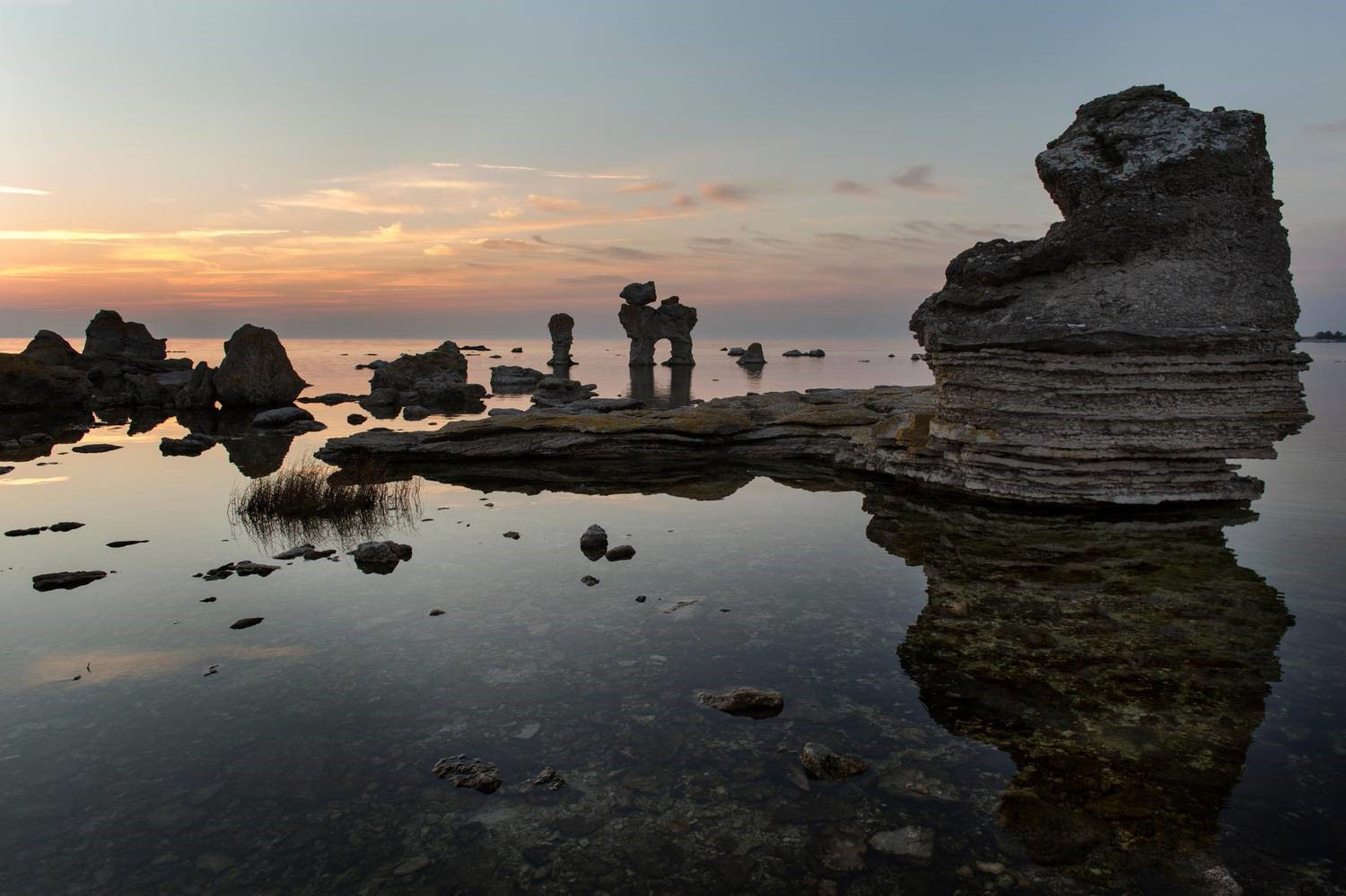
There is a large, forgotten island in the Baltic Sea, so large that it has freshwater rivers flowing into a sea, which is unique because of its mixture of salt and freshwater, bordering nine different countries in the Baltic Sea[1] with a total of 90 million people[2]: Denmark and Sweden to the west, Finland, Russia, Estonia, Latvia and Lithuania to the east, Poland and Germany to the south[3]. It is a beautiful island, unknown to most Europeans, despite being one and a half times the size of Luxembourg. Since it is the sunniest region of Sweden, it is also Sweden’s most agriculturally inclined area and, in the last quarter century, has become a favourite destination for young Swedes.
But all this is irrelevant compared to its military importance, especially now that Stockholm has joined NATO: it is the West’s extreme outpost on the Baltic Sea, and is (along with the Baltic republics) the prime strategic target of a Russia waging a new world war – because it controls vital air and maritime space, because missiles located on its territory can strike St. Petersburg, because from its military airfields NATO can drop over a hundred thousand troops on Russian soil in just 48 hours, becoming the key support point for supplies to any occupying troops. Gøtland has become even more important in recent months, since the West, facing the conflicts of interest of many of its politicians, paid by Gazprom, realised that Nord Stream 2 does not benefit Europe at all, but serves to punish Ukraine and the Eastern European countries that have become EU members.
So this almost forgotten island has suddenly become one of the hottest spots on the international geopolitical chessboard. Whoever controls Gøtland will also control the hydrocarbon supplies for the European Union and the new sea routes of the entire Arctic continent. But in order to tell the story of this island, and not just the dreaded war that could strike it as the first victim, it is worth telling the story of this almost forgotten area of the European Union.
The commercial and military centre of the Baltic Sea
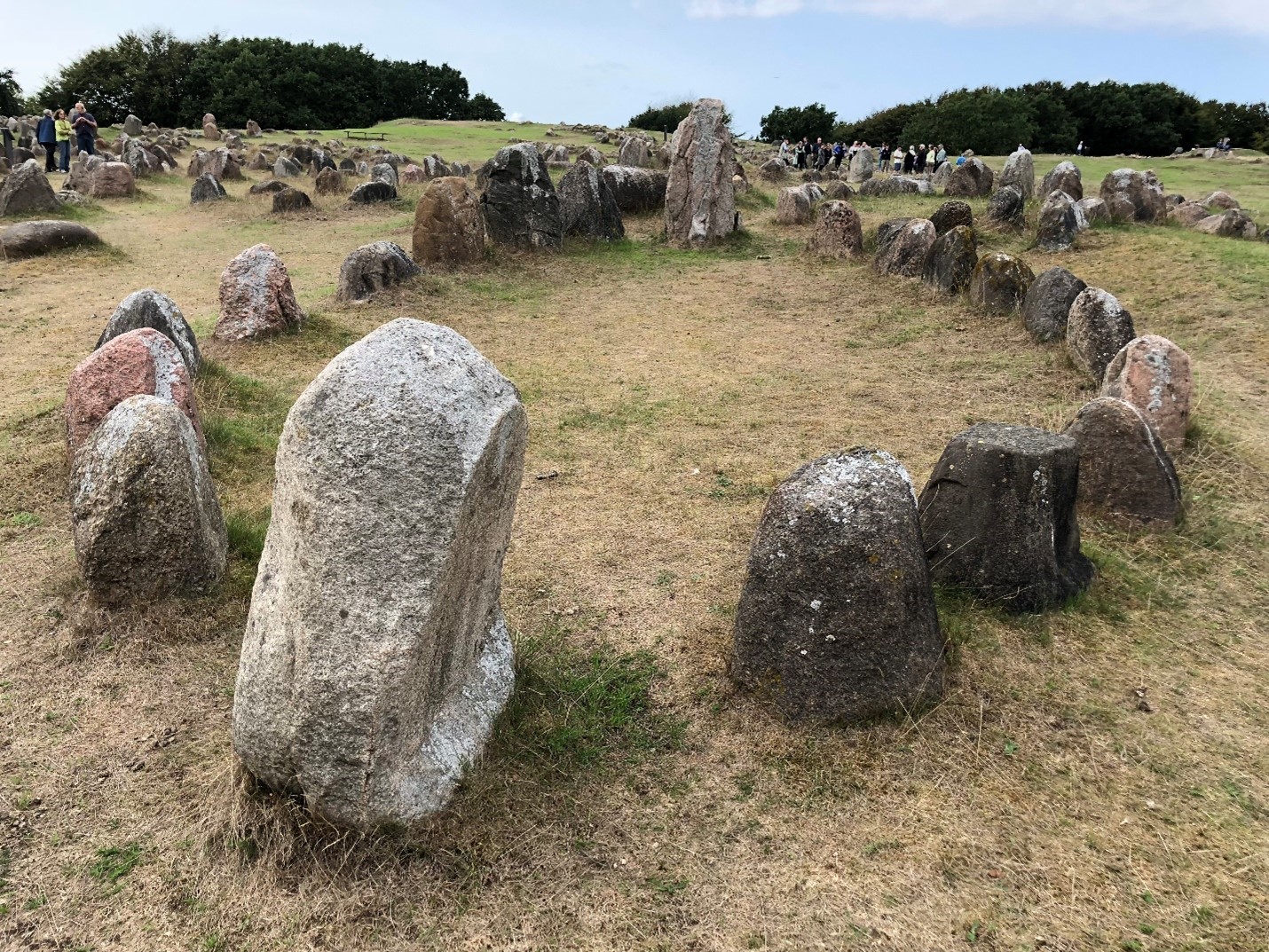
One of the many sites of Viking runes, under which treasures from European raids worth hundreds of millions of Euros have been discovered[4]
As early as the Viking Age (8th-10th century), Gøtland was a key trading centre in the life of the peoples around the Baltic Sea. Local peasants, united in associations, opened a trading office in Novgorod, Russia, called Gotenhof[5]. Things changed in 1161, when a treaty was signed in Artlenburg between the inhabitants of Gøtland and the German Duke Henry the Lion of Saxony[6], thanks to which the Germans began to settle on the island and were allowed to form their own community in Visby: they could build their own church (St. Per) and observe their own laws[7]. In July 1361, the King of Denmark conquered Gøtland at the Battle of Visby[8]. The Danish soldiers, who have great experience in battle, easily win over the peasants of Gøtland[9].
The Danish Crown ruled Gøtland until 1645, when the Peace of Brömsebro was signed[10]. In 1808, Russia occupied the island with 1800 soldiers, and the inhabitants surrendered. However, the occupation ended three weeks later, when Sweden sent reinforcements with 2000 soldiers to the island and at the same time cut off the Russian supplies: the occupants surrendered and left the island[11]. From then on, the history of the island is inextricably linked to the history of Sweden – a jewel that welcomes a million tourists a year and where only 61,000 people live[12].
It is an island of peace, far from the daily struggles: every year, at the beginning of July, the Almedalen Week (a.k.a. Politicians’ Week) is held here, which for the past 50 years has brought together all parties in the Riksdag to discuss the major issues of Swedish democracy without party preconceptions[13]. It is a meeting place open to everyone, not only politicians, but also civil society organisations[14]. For some years now, the main topic has been the melting of the ice and its consequences: the opening up of new shipping routes, access to hitherto unexplored natural resources – opening up a new sea, five times larger than the Mediterranean, in which the great powers will fight it out[15]. With bases in Gøtland, the Baltic Sea is controlled by sea and air[16].
Russia has a very long coastline on the Arctic Ocean, which is a natural protective barrier for the country, since 50% of the Arctic land mass is on Russian territory: when this disappears, the wall that has protected Russia will no longer be there[17]. The Russian Arctic Ocean Navy is stationed in Murmansk, which is very far away: a situation that is rapidly changing, with massive movements of troops and means, because in the event of a conflict with NATO, Russia wants to be able to defend itself. It is inevitable that Sweden will be involved: the island of Gøtland as first[18].
Peace talks between Russia and the West are held in the Arctic Council – a forum for cooperation between states working together for the sustainable development of the Arctic. The Council includes Denmark (with Greenland, Faroe Islands), Norway, Iceland, Finland, Canada, Russia, Sweden and the United States[19]. In 2021, Iceland, which then chaired the Arctic Council, ceded the chairmanship to Russia, whose seat on the council was suspended due to the invasion of Ukraine[20]. A process of military adjustment began immediately: on 13 January 2022, soldiers from all over Sweden arrived in Gøtland and began patrolling the streets, while the Gøtland Ferry unloaded American military vehicles and additional international resources landed at Visby Airport[21].
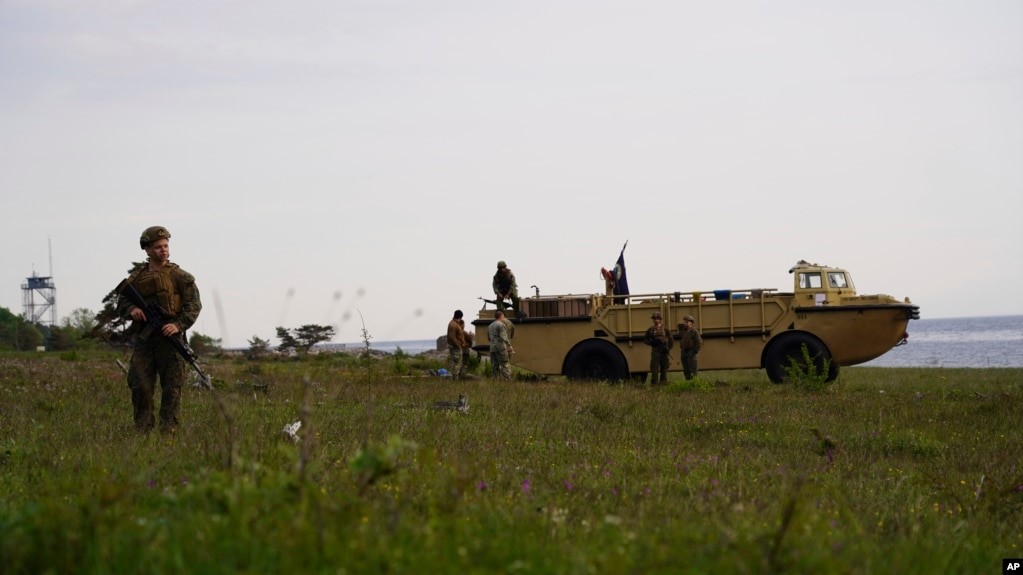
7 June 2022: NATO troops on patrol duty on the coast of Gøtland[22]
On 29 April 2022, Stockholm decided to strengthen the island’s defence, investing SEK 1.6 billion, as Finance Minister Max Elger explains: ‘The Russian invasion of Ukraine justifies increasing our military presence on Gøtland’[23], especially considering the fact that the island is only 300 km from the Russian enclave of Kaliningrad, where the Russian fleet in the Baltic is based, and the need to protect Scandinavia and the Baltic republics[24]. While Estonia, Latvia and Lithuania are already NATO members[25], Sweden formally applies for membership on 18 May 2022[26].
Gøtland became the focus of NATO’s activities as early as June, with the organisation of Baltops 22, a massive operation involving soldiers from almost all NATO countries (even Bulgaria), and whose purpose is to prepare for the defence of freedom of navigation in the Baltic and a possible counter-offensive on the continent and in the St Petersburg area[27]. Led by the US Sixth Fleet, the exercise has as its epicentre the island, which is where the military and amphibious aircraft that land in Estonia, Latvia and Lithuania depart from[28]. The mood of the Swedish people is interpreted by Colonel Magnus Frykvall, commander of the Swedish troops engaged in the exercise: ‘I feel really prepared now. I want to say that with this deployment we can defend Gøtland; storming such an impregnable island is a really difficult task”[29]. Frykvall says that there are currently 400 military personnel on the island, but their presence is set to grow rapidly: the military leadership expects a deployment of 4,000 men[30].
The militarisation of Gøtland had already been prepared by a Swedish law of 2015, which provides for major investments in the modernisation of tanks and other combat vehicles, infantry armament, new mortars, anti-tank weapons, but also submarines[31]. This last point is the most important, in light of the incident in October 2014, when a Russian submarine was spotted in Swedish territorial waters[32]. In 2016, the Swedish government privately purchased the port of Kappelshamn, which it had previously sold[33], and since 2017 has been using it for military exercises[34].
In February 2017, Stockholm bought back another military facility that had been sold to private individuals at the beginning of the 21st century as part of defence budget cuts: the submarine base at Fårösund. The purchase was finalised in January 2018, winning an auction whose biggest competitor was an anonymous Russian oligarch – news that increased the haste and fear in Stockholm[35]. The Armed Forces bought back the port from Artmax AB (Stockholm)[36] from a Hong Kong businessman, who wanted to lease it[37]. Kappelshamn and Fårösund are located on the island of Gøtland.
The inhabitants of Gøtland are worried: seeing soldiers in the streets suggests that the situation is serious[38]. Fear is also spreading among the Russians living on the island: most of them do not dare give an interview. One woman says she is very afraid that someone will burn her house down or that she will say something wrong and the Russian government will prosecute her[39]. There is a risk of being chased away and having to return to a homeland that will not welcome them, but only give them an icy mistrustful welcome[40].
The Nord Stream case
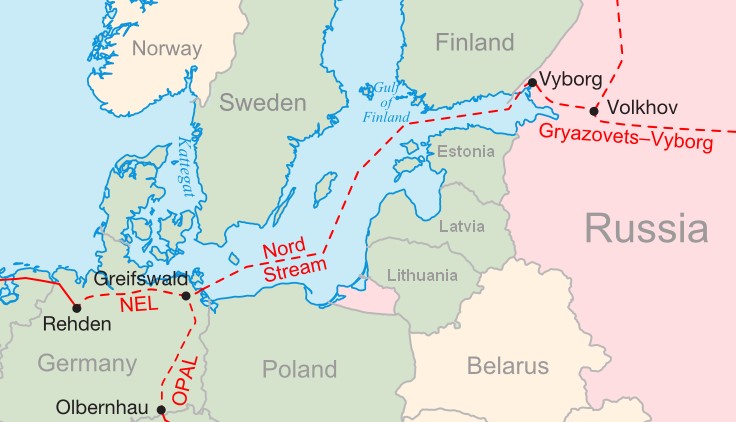
The map of the submarine pipeline Nord Stream 2, which crosses the Baltic a few kilometres from Gøtland[41]
Nord Stream is a double gas pipeline that connects Vyborg (Russia) across the Baltic Sea to Lubmin (Germany), crossing the territorial waters of Russia, Finland, Sweden, Denmark and Germany[42]. The gas comes from the Bovanenkovo field (Jamal Peninsula), containing 4.9 trillion cubic metres of gas[43]; from there 55 billion cubic metres per year reach Europe[44]. The initial EUR 7.4 billion, calculated for construction, rises to EUR 8.8 billion during the first stages of realisation[45]. Recognised by the European Commission as an urgent project in 2000, its construction, for the onshore part, begins in 2010 and is completed in 2011 (pipe 1) and 2012 (pipe 2)[46].
The construction of Nord Stream 2 starts in 2018 and is completed in September 2021[47]; Nord Stream’s sister pipeline is designed to transport an additional 55 billion cubic metres of gas from Siberian gas fields[48] from Ust-Luga (near St. Petersburg) to Lubmin[49]. Nord Stream 2 is being realised by the Swiss consortium Nord Stream 2 AG Zug, a wholly owned subsidiary of the Russian state giant Gazprom[50], with which the Western companies Uniper SE (Düsseldorf), Wintershall Dea AG (Kassel/Hamburg), Engie SA (Paris), OMV AG (Vienna) and Royal Dutch Shell Plc (London) (from 21 January 2022 Shell Plc[51]) signed a financing agreement in 2017, in which each pledges to contribute €950 million; the remaining €4. 75 billion required is guaranteed by Gazprom[52]. On 22 February 2022, Germany halted the project following the events in Ukraine[53].
These submarine gas pipelines allow Russia on the one hand to avoid Eastern European countries by directly connecting Moscow with Germany, and on the other hand to put Ukraine, which through the GTS (Gas Transmission System) transports up to 69 billion cubic metres of gas per year to Europe[54] from the Siberian Urengoy field[55], in a difficult situation. The Russian boycott campaign against the GTS revolves around three points: 1) the gas transmission system is based on obsolete technology, unable to handle the high-pressure flow of the material; 2) Ukraine is an unreliable partner that illegally steals part of the gas destined for Europe during transit through its territory[56]; 3) Ukraine uses dangerous US technologies to extract shale gas from deep in the earth, causing an environmental catastrophe[57].
This is part of the propaganda used to justify the invasion, and must be evaluated knowing what the real problem is with Putin’s imperial policy in response to his own failures at home. In any case, in October 2021 the Ukrainian Ministry of Energy announced its plan for the development and modernisation of the GTS (from 1 January 2020 owned by the public company JSC Mahistralni Gazoprovody Ukrainy[58]), which envisages investments of €1.5 billion in technical upgrades by 2031[59]. Kiev denies ever stealing gas destined for Europe[60], and accuses Russia of stealing gas in transit through the occupied province of Luhansk[61].
According to estimates by the U.S. Energy Information Administration (EIA), there are huge shale gas deposits of 3.5 trillion cubic metres under Ukrainian soil[62]; Ukraine is one of the few European countries where fracking (necessary to extract shale gas) is not banned[63]. This is a deep excavation technique that uses high-pressure water, which is considered extremely harmful to the environment due to the potential pollution of aquifers and the immense water consumption required for the operations[64].
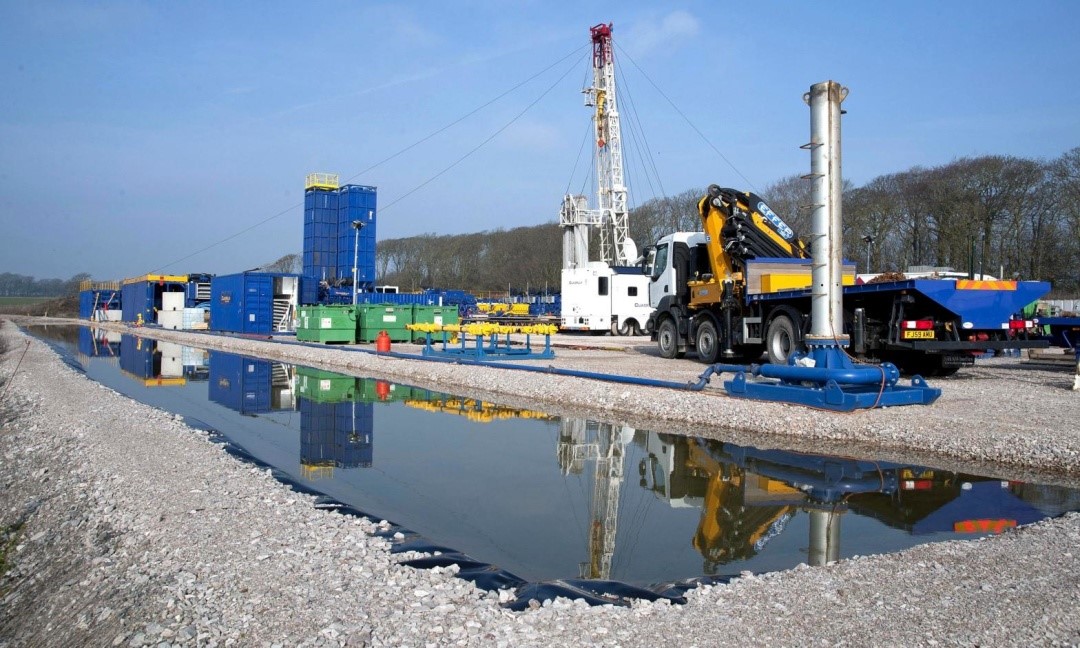
The Ukrainian shale gas production station in Yuzivska[65]
The largest of the shale gas reserves (2.15 trillion cubic metres) is located in Yuzivska, an area between Donetsk and Kharkiv: in 2013, the Ukrainian government signed a production sharing agreement (lasting 50 years) with Shell Group and Nadra Yuzovsky Llc for this field[66]. In the same year, Chevron Ukraine BV and Nadra Oleska sign a similar agreement for the Oleska field, near Lviv (at the end of 2014, this project is halted due to falling oil prices, taxation problems and political instability in the country[67])[68].
Shell abandoned its exploration projects in June 2015 due to the ongoing conflict between Ukrainian forces and pro-Russian separatists[69], marking the end of Ukraine’s dream of achieving energy independence through which it would become a formidable competitor to Gazprom[70]. The onset of the period of strong instability in the Donbass suggests that Moscow thus decided to nip in the bud a serious threat to the viability of its state-owned company, while maintaining an effective lever of political pressure on Ukraine and Europe. This manoeuvre, coupled with the commissioning of Nord Stream 2, would have resolved the issue for good.
The closure of the Nord Stream 2 project is welcomed by the United States, which has always been a fierce opponent of the operation[71], and which in 2019[72], 2021[73] and 2022[74] imposed sanctions on the companies involved in its construction. Since the beginning of the affair, Washington has looked with extreme suspicion at the relations between Berlin and Moscow on the energy front, fearing the creation of an excessive dependence of the European allies on Russian gas, the export of which – if Nord Stream 2 had come into operation – would have de facto cancelled the sanctions against Moscow (in force since 2014) following the Ukrainian crisis[75]. Economic interests are not secondary: by pushing for the failure of Nord Stream 2, the United States also hopes to enter the race for European supplies by exporting its own liquefied natural gas[76].
The countries of the Visegrád agreement (Poland, Hungary, the Czech Republic and Slovakia) also frown on Nord Stream 2 and welcome the news of its closure: Warsaw is worried about the consequences of a manoeuvre that would undermine the pluralism of supplies and Europe’s energy security[77]; Slovakia, the Czech Republic and Hungary fear, in various ways, serious economic damage from the loss of commercial transit rights, which would materialise with the closure of the Ukrainian pipeline in favour of Nord Stream 2[78].
Since the annexation of Crimea in 2014, Russia has intensified its military activity in the Baltic, prompting Sweden (2016) to establish a permanent garrison on the island of Gøtland, after it had been demilitarised in 2005[79]. Linked to these concerns is also the interest expressed by Nord Stream 2 AG[80], whose board of directors is chaired by former German chancellor Gerhard Schröder[81], in the use of some Swedish infrastructure, including a port in Slite (Gøtland)[82] and one in Karlshamn (Blekinge county, 150 km northeast of Malmö)[83], for the construction of the pipeline. The then prime minister Stefan Löfven and, above all, the supreme commander of the Swedish Armed Forces, Micael Bydén, expressed strong concerns about the potential risks of granting Russia the use of strategic Swedish infrastructure[84].
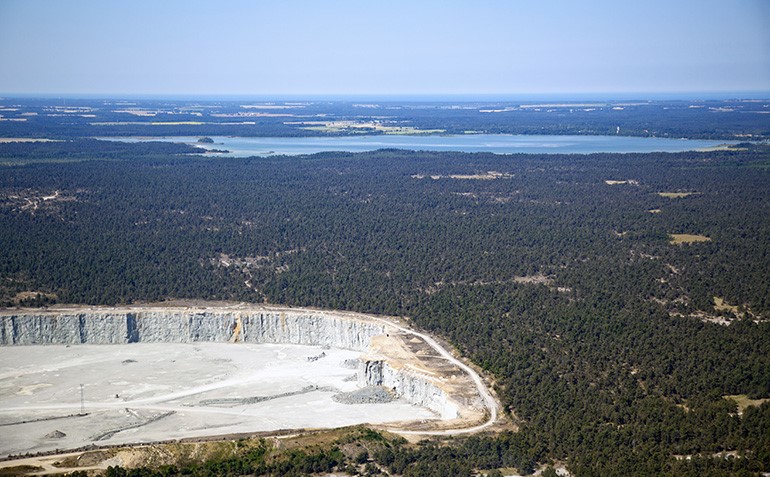
The Slite mines, a few kilometres as the crow flies from the commercial and military port of the same name, one of Sweden’s main sources of cement supply, now closed for fear of Russian attacks[85]
Fear of Stockholm led the island’s government to reconsider its initial approval of the operation[86], despite assurances from Russian ambassador Victor Tatarintsev[87]. At the end of January 2017, the municipality of Karlshamn authorised Nord Stream 2 AG to use a section of its port for the construction of the pipeline[88]; the work involving Karlshamn began on 7 October 2017, under the control of Wasco Coating Company GmbH, and ended on 4 August 2019, after 23 months of work and 39,000 pipes passed through, which was useful for laying most of the pipeline in the Swedish section of the route[89]. The port of Slite, on the other hand, is ultimately not used for the construction of Nord Stream 2: pressure from the Swedish central government on the island, albeit belatedly, has the desired effect, but it does not spare Stockholm fierce criticism from the local press for not having been able to let national security prevail in the case of Karlshamn as well[90].
In addition to the changed political situation, which increasingly sees Gøtland as the nerve centre of a very turbulent territory[91], the precedent of the first Nord Stream project, for which the port of Slite was used, is also behind the refusal to grant the use of the port for the construction of the pipeline: in 2008, the approval of the project brought with it concerns over the opacity of Russian foreign policy and the heavy consequences on the already fragile and tested Baltic ecosystem[92]. Stockholm gave permission for use anyway[93].
Suspicions of corruption
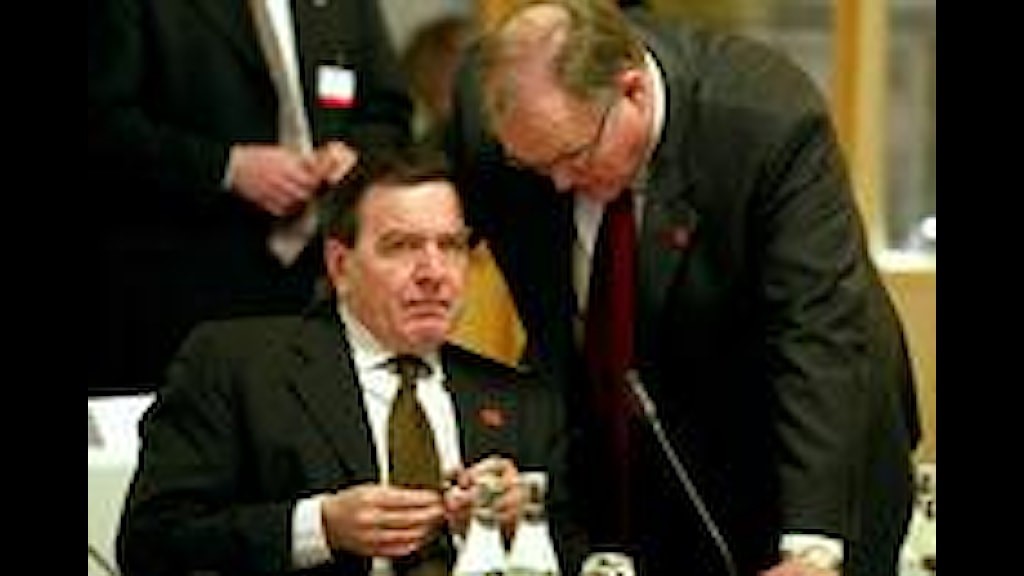
Former German Chancellor Gerhard Schröder (left) and former Swedish Prime Minister Göran Persson (right), ex-politicians and now lobbyists in the pay of Gazprom[94]
It is a decision that goes back a long way. In 1997, President Boris Yeltsin said in a speech to the Swedish government: ‘We have decided that we will have a gas pipeline from Russia to Sweden’, which was followed by a strong no from the then Swedish Prime Minister Göran Persson: ‘In Sweden I decide’[95]. When Putin came to power[96] he immediately took over the project: in 2005, the planning of Nord Stream was completed, with the signing of the commercial agreement between BASF (the German chemical group), Eon (the German energy group) and Gazprom[97]. The Swedish government’s authorisation is required to start the project, as the Russian pipes will enter Swedish territorial waters[98]. Prime Minister Göran Persson does not want[99].
In 2006 Fredrik Reinfeldt becomes Prime Minister of Sweden and appoints Carl Bildt, an unscrupulous businessman, among other things a board member of Vostok Naftas, as Foreign Minister[100]. When the news of his appointment becomes public, Carl Bildt is forced to resign[101]. But he retains ownership of shares in the company worth around SEK 1 million[102], which means he owns shares in Gazprom subsidiaries[103]. Bildt finds himself in an obvious conflict of interest. When the press increases pressure on his indirect shareholding in Gazprom, Bildt sells his shares[104]. However, he sells them in exchange for options, convertible into shares, for about SEK 5 million[105].
Göran Persson, for years an opponent of Nord Stream, is hired by the public relations company JKL in 2007[106]. The co-owner of Nord Stream, Eon, is one of its main clients[107]. A few days before signing the contract of employment, Göran Persson sits down to dinner with Gerhard Schröder[108]. In 2009, Sweden approves the Russian gas pipeline[109]. Professor Kjell Larsson (Gøtland University), who warned in early 2007 that the pipelines would be built too close to sensitive natural areas[110], receives 5 million kroner from Nord Stream to conduct research on seabirds and keep his mouth shut[111]. Malin Palmgren, prosecutor at the National Anti-Corruption Unit, denounced him[112]: the charges were dropped because Kjell Larsson left the university’s consultancy work on the pipeline[113].
Politicians in the municipality of Gøtland receive 70 million kroner to renovate Slite harbour, to be used for the construction of the pipeline[114]. Dan Svanell, former press secretary to seven Social Democratic ministers and one of Sweden’s most experienced communicators, becomes Nord Stream’s public relations consultant with a monthly salary of more than 100,000 kronor[115]. At the same time, the municipality of Karlskrona signs a contract with Nord Stream for over 30 million kronor for the rent of the municipality’s harbour area[116]. The question arises: why have Swedish politicians suddenly changed their minds about Nord Stream 2?
On 7 June 2018, the Ministry of Enterprise and Innovation grants Nord Stream 2 AG permission to lay the pipeline pair in the territorial waters of the Baltic Sea. Minister Mikael Damberg makes it clear that Sweden, like Finland shortly before, could not object to a rule of international law that guarantees all states the laying of undersea pipelines, pointing out that his country and Denmark had raised serious questions within the European Union about the energy policy, legal and security aspects of the Nord Stream 2 project[117].
All this became irrelevant after the invasion of Ukraine. On 20 June 2022, Lithuania, in compliance with sanctions imposed by the European Union on certain Russian goods, blocked the railway transfer of a long list of goods to Kaliningrad, provoking a threatening reaction from the Kremlin[118]. In that city, the inhabitants panic and empty the shelves of supermarkets[119], even though only a few goods have been blocked: different types of shops are regularly restocked, as are petrol stations. Building materials, on the other hand, will soon start to run out[120]. From now on, on the island of Gøtland, it is best to be ready for anything.
[1] https://www.varldenshaftigaste.se/topplistor/sveriges-10-storsta-oar/
[2] https://www.havet.nu/egentliga-ostersjon
[3] https://viss.lansstyrelsen.se/MarineRegions.aspx?marineRegionEUID=BAL-SE-RG-Ostersjon
[4] https://www.britannica.com/video/179860/Overview-archaeologists-efforts-treasure-Viking-Sweden-island ; https://dna-explained.com/2020/09/18/442-ancient-viking-skeletons-hold-dna-surprises-does-your-y-or-mitochondrial-dna-match-daily-updates-here/
[5] https://popularhistoria.se/civilisationer/novgorod
[6] https://www.so-rummet.se/kategorier/Gøtlands-historia#
[7] https://www.so-rummet.se/kategorier/Gøtlands-historia#
[8] https://historia.nu/historia-nu/det-tragiska-slaget-om-visby-1361/
[9] https://historiska.se/utstallningar/massakern-vid-muren/
[10] https://www.so-rummet.se/kategorier/Gøtlands-historia
[11] https://www.svd.se/a/fd0b10c0-48fe-490f-abeb-425edc5ff70f/hur-lange-var-Gøtland-ockuperat-av-ryssland
[12] https://Gøtlandsbesoksnaring.se/wp-content/uploads/2021/12/Beso%CC%88ksna%CC%88ringens-betydelse-fo%CC%88r-Gøtland-2021-12-09-1.pdf
[13] https://almedalsveckan.info/om-almedalsveckan
[14] https://www.almedalsveckan.info/om-almedalsveckan
[15] https://www.forsvarsmakten.se/sv/var-verksamhet/forsvarsmakten-i-sverige/sakerhetslaget-i-naromradet/
[16] https://alltsvarade.se/hur-kan-ryssland-hota-sverige
[17] https://www.forsvarsmakten.se/sv/var-verksamhet/forsvarsmakten-i-sverige/sakerhetslaget-i-naromradet/
[18] https://www.regeringen.se/4a8365/contentassets/000d750cc7d941b98abedf844a07529f/regeringens-skrivelse-2020-21-7.pdf
[19] https://ibiworld.eu/en/the-secret-war-for-the-arctic-ocean/
[20] https://www.naturvardsverket.se/om-miljoarbetet/internationellt-miljoarbete/multilateralt-miljosamarbete/arktiska-radet/
[21] https://www.gp.se/nyheter/sverige/milit%C3%A4r-fr%C3%A5n-hela-sverige-anl%C3%A4nder-till-Gøtland-1.63836947
[22] https://www.voanews.com/a/swedish-us-troops-drill-on-remilitarized-baltic-sea-island/6614591.html
[23] https://omni.se/1,6-miljarder-for-att-starka-forsvaret-pa-Gøtland/a/7dvqOV
[24] https://www.reuters.com/world/europe/swedens-Gøtland-crossroads-history-nato-decision-looms-2022-05-10/
[25] https://www.nato.int/cps/en/natohq/topics_52044.htm
[26] https://www.nato.int/cps/en/natohq/topics_52535.htm
[27] https://shape.nato.int/news-archive/2022/baltops-22-kicks-off-in-the-baltic-sea
[28] https://www.navy.mil/Press-Office/News-Stories/Article/3066830/baltops-22-the-premier-baltic-sea-maritime-exercise-concludes-in-kiel/
[29] https://www.voanews.com/a/swedish-us-troops-drill-on-remilitarized-baltic-sea-island/6614591.html
[30] https://www.nytimes.com/2022/06/12/world/europe/us-sweden-military-drill.html
[31] https://www.lejournalinternational.fr/L-isola-di-Gøtland-riaccende-le-tensioni-tra-NATO-Svezia-e-Russia_a3095.html
[32] https://www.theguardian.com/world/2014/oct/19/sweden-search-russian-submarine-stockholm
[33] https://www.bairdmaritime.com/work-boat-world/maritime-security-world/naval/submersibles-naval/sweden-buys-back-second-Gøtland-submarine-base/?format=feed&limitstart
[34] https://www.bloomberg.com/news/photo-essays/2017-10-18/sweden-eyes-russia-while-holding-its-own-war-games
[35] https://www.navaltoday.com/2018/01/19/sweden-buys-back-previously-sold-Gøtland-submarine-base/
[36] https://www.artmaxproperty.com/
[37] https://www.expressen.se/nyheter/marinhamnen-i-farosund-sald/ ; https://helaGøtland.se/ekonomi/nya-turer-kring-en-marklig-hamnaffar-14988179.aspx
[38] https://www.dn.se/sverige/soldater-pa-gatorna-i-visby-man-paminns-om-allvaret/
[39] https://omni.se/1%2C6-miljarder-for-att-starka-forsvaret-pa-Gøtland/a/7dvqOV ; https://omni.se/svenska-soldater-ovar-med-usa-pa-Gøtland-man-tjanar-verkligen-ett-syfte/a/XqVWPo ; https://www.forsvarsmakten.se/sv/aktuellt/2022/06/samarbete-i-luften-over-nationsgranserna/ ; https://www.dagensjuridik.se/debatt/debatt-ett-svenskt-Gøtland-eller-inte/ ; https://www.dn.se/sverige/soldater-pa-gatorna-i-visby-man-paminns-om-allvaret/ ; https://sverigesradio.se/artikel/oro-bland-ryssar-pa-Gøtland-det-vacks-ett-hat
[40] https://sverigesradio.se/artikel/oro-bland-ryssar-pa-Gøtland-det-vacks-ett-hat
[41] https://en.wikipedia.org/wiki/Nord_Stream#/media/File:Nordstream.png
[42] https://www.nord-stream.com/the-project/pipeline/
[43] https://thebarentsobserver.com/en/industry-and-energy/2017/01/more-arctic-gas-europe-russia-opens-new-pipeline
[44] https://wintershalldea.com/en/newsroom/nord-stream-ten-years-secure-energy-supply
[45] https://web.archive.org/web/20110707213810/http://www.barentsobserver.com/nord-stream-more-expensive.4760460-116321.html
[46] https://www.unav.edu/web/global-affairs/detalle/-/blogs/the-nord-stream-2-divides-the-eu
[47] https://www.reuters.com/article/nordstream-gas-usa-idAFL1N2OY0JY
[48] https://www.cleanenergywire.org/factsheets/gas-pipeline-nord-stream-2-links-germany-russia-splits-europe
[49] https://ukandeu.ac.uk/the-facts/what-is-nord-stream-2/
[50] https://www.reuters.com/markets/europe/exclusive-nord-stream-2-owner-considers-insolvency-after-pipeline-halt-sanctions-2022-03-01/
[51] https://www.shell.com/media/news-and-media-releases/2022/royal-dutch-shell-plc-changes-its-name-to-shell-plc.html
[52] https://www.osw.waw.pl/en/publikacje/analyses/2017-04-26/nord-stream-2-financing-agreements
[53] https://www.reuters.com/business/energy/germanys-scholz-halts-nord-stream-2-certification-2022-02-22/ ; https://www.politico.eu/article/vladimir-putin-russia-ukraine-donbass-separatist-recognition/
[54] https://www.ukrinform.net/rubric-economy/3341204-ukrainian-gts-ready-to-ship-additional-gas-volumes-to-europe.html
[55] https://www.hydrocarbons-technology.com/projects/urengoy-gas-and-condensate-field-development-russia/ ; Simon Pirani, “Russian gas transit through Ukraine after 2019: the options”, The Oxfrod Insistute forEnergy Studies, 2018, p. 16
[56] https://www.theguardian.com/world/2009/jan/03/russia-ukraine-gas-supplies-gazprom
[57] https://uacrisis.org/en/top-3-russian-myths-about-ukraine-s-gas-transmission-system
[58] https://tsoua.com/en/about-us/history/ ; https://tsoua.com/en/news/unbundling-is-completed-an-independent-gts-operator-began-to-work/
[59] https://www.ukrinform.net/rubric-economy/3332184-over-uah-46b-already-invested-in-ukraines-gts-in-2021-as-part-of-modernization.html
[60] https://www.reuters.com/business/energy/is-war-ukraine-impacting-russian-gas-supplies-europe-2022-03-07/
[61] https://www.ukrinform.net/rubric-economy/3480714-gtsou-says-russia-steals-gas-within-temporarily-occupied-territories.html ; https://www.washingtonpost.com/world/2022/05/11/ukraine-naftogaz-halt-russia-gas-gazprom-europe/
[62] https://www.eia.gov/analysis/studies/worldshalegas/
[63] https://www.bloomberg.com/quicktake/fracking-europe#xj4y7vzkg
[64] Olena Miskun, Vladlena Martsynkevych, Antoine Simon, “The dash for gas in Ukraine – Current trends in the production of unconventional reserves”, National Ecological Centre of Ukraine and CEE Bankwatch Network, 2014, p.5
[65] https://www.ukrinform.net/rubric-society/3372912-yuzivka-between-fakes-and-the-truth-of-ukraines-gas-independence.html
[66] http://shalegas.in.ua/en/shale-gas-resources-in-ukraine/
[67] https://www.ft.com/content/76b41d9c-847e-11e4-ba4f-00144feabdc0
[68] http://shalegas.in.ua/en/ukrajina-pidpysala-urp-z-shevron/
[69] https://www.ft.com/content/0c66011e-104a-11e5-bd70-00144feabdc0
[70] https://www.euractiv.com/section/energy/opinion/russia-s-silent-shale-gas-victory-in-ukraine/
[71] https://www.republicworld.com/world-news/russia-ukraine-crisis/russia-ukraine-war-russian-nord-stream-2-gas-pipeline-is-dead-says-us-under-secy-nuland-articleshow.html
[72] https://www.cnbc.com/2019/12/18/us-sanctions-on-nord-stream-2-pipeline.html
[73] https://www.reuters.com/business/energy/us-imposes-further-sanctions-connection-with-nord-stream-2-gas-pipeline-2021-11-22/
[74] https://www.reuters.com/business/energy/us-plans-sanctions-company-building-russias-nord-stream-2-pipeline-cnn-2022-02-23/
[75] https://theconversation.com/what-the-lifting-of-us-sanctions-means-for-the-nord-stream-2-pipeline-165275
[76] https://www.swp-berlin.org/10.18449/2019C06/
[77] https://kafkadesk.org/2019/11/14/poland-slaps-a-e40-million-fine-on-frances-engie-over-nord-stream-2-project/ ; https://kafkadesk.org/2021/05/21/poland-angered-by-us-president-bidens-nord-stream-ii-decision/
[78] https://kafkadesk.org/2021/08/18/nord-stream-ii-whats-at-stake-for-central-and-eastern-europe/
[79] https://www.reuters.com/article/sweden-nord-stream-idUSL5N1E93WW
[80] https://www.bloomberg.com/profile/company/1691175D:SW
[81] https://www.reuters.com/business/energy/russias-rosneft-says-german-ex-chancellor-schroeder-quits-board-2022-05-20/ ; https://www.dw.com/en/germanys-former-chancellor-gerhard-schr%C3%B6der-to-join-gazprom-board/a-60664273
[82] https://www.thelocal.se/20161210/Gøtland-split-by-discussions-of-russian-pipeline/
[83] https://www.karlshamnshamn.se/en/nord-stream-2-potential-large-business-and-new-work-places-port-karlshamn
[84] https://www.thelocal.se/20161208/russia-we-have-no-plans-to-invade-sweden/
[85] https://www.lansstyrelsen.se/gotland/om-oss/nyheter-och-press/nyheter—gotland/2018-11-22-avstyrker-tillstand-for-kalkbrytning.html
[86] https://www.thelocal.se/20161214/Gøtland-says-no-to-leasing-port-to-russian-gas-project/
[87] https://www.svt.se/nyheter/utrikes/rysslands-sverigeambassador-vi-har-inte-ockuperat-krim
[88] https://www.eurotopics.net/en/173669/karlshamn-goes-rogue-on-nord-stream-2
[89] https://www.euro-petrole.com/nord-stream-2-last-pipe-leaves-port-of-karlshamn-n-i-19179
[90] aftonbladet.se/ledare/a/pRR81/gasledningen-ar-rysk-maktpolitik ; https://www.sydsvenskan.se/2017-01-31/utan-raka-ror-i-regeringen-blir-det-ryska-ror
[91] https://www.reuters.com/world/europe/sweden-boost-military-Gøtland-amid-russia-fears-2022-04-29/
[92] Karin Edberg, Anna-Lisa Fransson, Ingemar Elander “Island and the Pipeline: Gøtland Facing the Geopolitical Power of Nord Stream”, Örebro University, School of Humanities, Education and Social Sciences, 2017, pp. 33-35
[93] https://www.svd.se/a/c90bec9e-9604-3c6f-86b6-c8bc1dc616ea/klart-for-omstridd-gasledning
[94] https://sverigesradio.se/artikel/734595
[95] https://www.youtube.com/watch?v=t1xadpx0Z_g ; https://www.gp.se/nyheter/sverige/f%C3%A5-men-minnesv%C3%A4rda-ryska-m%C3%B6ten-1.14433954
[96] http://en.kremlin.ru/events/president/transcripts/22280
[97] https://kvartal.se/artiklar/carl-bildt-pengarna-och-den-ryska-gasen-under-ytan/
[98] https://www.europaportalen.se/2009/11/svenskt-ja-till-omstridd-gasledning-0
[99] https://www.svd.se/a/77801742-8eed-3472-9ce6-7fdff424edfb/svart-att-stoppa-gasledning
[100] https://sverigesradio.se/artikel/1316344
[101] https://www.mynewsdesk.com/se/vostok_nafta/pressreleases/carl-bildt-laemnar-vostok-naftas-styrelse-108782
[102] https://www.varldenidag.se/ledare/politiska-beslut-till-salu/cbbigA!b2cFe2o2cf6IL21PJ9VHvg/
[103] https://svenska.yle.fi/a/7-177642
[104] https://www.svd.se/a/07e48c86-514d-317d-95f5-e2028fc59fc8/bildt-viker-sig-drar-sig-ur-vostok-nafta
[105] https://kvartal.se/artiklar/carl-bildt-pengarna-och-den-ryska-gasen-under-ytan/
[106] https://www.resume.se/alla-nyheter/nyheter/goran-perssons-lon-1-3-miljoner/
[107] https://kvartal.se/artiklar/carl-bildt-pengarna-och-den-ryska-gasen-under-ytan/
[108] https://www.svd.se/a/1810db7f-f1c5-3a3b-ad7e-24b534a40f06/goran-persson-blir-pr-konsult
[109] https://svenska.yle.fi/a/7-351566
[110] https://www.varldenidag.se/ledare/politiska-beslut-till-salu/cbbigA!b2cFe2o2cf6IL21PJ9VHvg/
[111] https://www.tv4.se/artikel/4fc3b89804bf72228b00c4ca/vad-har-hant-hittills
[112] https://www.varldenidag.se/ledare/politiska-beslut-till-salu/cbbigA!b2cFe2o2cf6IL21PJ9VHvg/
[113] https://kvartal.se/artiklar/carl-bildt-pengarna-och-den-ryska-gasen-under-ytan/
[114] https://www.aftonbladet.se/nyheter/a/ngL65J/vi-har-inte-blivit-kopta
[115] https://campaigndossier.wordpress.com/tag/dan-svanell/
[116] https://www.varldenidag.se/ledare/politiska-beslut-till-salu/cbbigA!b2cFe2o2cf6IL21PJ9VHvg/
[117] https://www.government.se/press-releases/2018/06/decision-on-application-from-nord-stream-2-ag/
[118] https://www.washingtonpost.com/world/2022/06/21/kaliningrad-lithuania-russia-reaction/ ; https://www.repubblica.it/esteri/2022/06/20/news/blocco_di_kaliningrad_si_riaccende_la_tensione_europarussia-354732012/?ref=RHTP-BH-I347279517-P6-S2-T1
[119] https://www.theguardian.com/world/2022/jun/20/russia-condemns-lithuania-transit-ban-some-goods-kaliningrad
[120] https://www.washingtonpost.com/world/2022/06/21/kaliningrad-lithuania-russia-reaction/
Leave a Reply